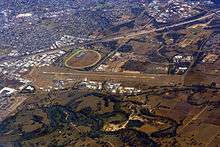Albury Airport
| Albury Airport | |||||||||||
|---|---|---|---|---|---|---|---|---|---|---|---|
|
Overview of the airport from the south-east | |||||||||||
| IATA: ABX – ICAO: YMAY | |||||||||||
| Summary | |||||||||||
| Airport type | Public | ||||||||||
| Operator | Albury City Council | ||||||||||
| Serves | Albury, New South Wales, Wodonga, Victoria | ||||||||||
| Elevation AMSL | 539 ft / 164 m | ||||||||||
| Coordinates | 36°04′06″S 146°57′30″E / 36.06833°S 146.95833°ECoordinates: 36°04′06″S 146°57′30″E / 36.06833°S 146.95833°E | ||||||||||
| Website | |||||||||||
| Map | |||||||||||
 YMAY Location in New South Wales | |||||||||||
| Runways | |||||||||||
| |||||||||||
| Statistics (FY 2015-16[1]) | |||||||||||
| |||||||||||
Albury Airport (IATA: ABX, ICAO: YMAY) is a regional airport located 2 nautical miles (3.7 km; 2.3 mi) northeast Albury, New South Wales, Australia. The airport, which also serves Albury's adjacent sister city of Wodonga, Victoria was the fifth busiest in New South Wales as of 2016. The airport also hosts the official weather station for Albury-Wodonga.
History
Although the site had been laid out as an aerodrome since the late 1930s, it was not until 1963 that construction to allow regular passenger flights to Sydney and Melbourne was completed, with the first flights arriving on 16 December that year. The airport was officially opened by the Minister for National Development David Fairbairn on 13 September 1964.[4]
The late 1970s and early 80s were a period of rapid growth at Albury airport, which benefited from expansion fuelled by the Albury-Wodonga National Growth Centre project. Upgrades to the runway were completed at this time to permit the operation of regional jet aircraft such as the Fokker F28. A control tower and new terminal were constructed and passenger numbers almost doubled between 1983 (82,000) and 1986 (160,000). The main carriers serving Albury at this time included East-West, Air NSW and Kendell Airlines. The airport funded further expansion with funds from landing and departure fees, levied at $1.50 per passenger.[5]
Further extensions to the passenger terminal to incorporate new security screening facilities were completed in 2009 at a cost of around $5 million.
Airlines and destinations
| Airlines | Destinations |
|---|---|
| QantasLink operated by Eastern Australia Airlines | Sydney |
| Regional Express | Melbourne, Sydney |
| Virgin Australia | Sydney |
| JETGO | Brisbane |
The airport is serviced twice daily by Virgin Australia who utilise 68-seat ATR-72s to Sydney; QantasLink who utilise a combination of 50 seat Dash 8-300s and 74 seat Dash 8-400s to Sydney; Regional Express (REX) who utilise 36 seat Saab 340s on services to Sydney and Melbourne. JETGO Australia introduced jet services to Brisbane in June 2016 using 36-seat Embraer ERJ-135LRs.
Previously, jet services had been operated by Virgin Australia, which launched services to Albury on 5 February 2008 (as Virgin Blue) with double-daily flights using Embraer 170s before the type was phased out of their fleet. During the 1980s and early 90s, East-West served Albury with Fokker F28 jets. Brindabella Airlines provided a direct service to Canberra, but this ended controversially in 2012 when the airline cited an expected increase in operating costs due to the implementation of the a Carbon pricing scheme by set to be introduced by the Gillard Government.[6]
In 2014, nonstop flights using 737 aircraft were looked at to Brisbane to give both direct access to Queenslanders to Victorian ski resorts & to locals from Albury region, direct access to south east Queensland (Brisbane, Gold & Sunshine Coasts) without having to fly through Sydney. Larger nonstop aircraft would reduce travel time & costs significantly.
The airport is also served by charter, freight, agricultural, and general aviation aircraft. Until 4 March 2002 Kendell Airlines served Albury, flying to Sydney and Melbourne.
Operations
| Rank | Airport | Passengers | % change | Carriers |
|---|---|---|---|---|
| 1 | |
216 965 | |
Virgin Australia, QantasLink, Regional Express |
.jpg)

| Year[1] | Passenger numbers |
|---|---|
| 2001-02 | 122,493 |
| 2002-03 | 130,865 |
| 2003-04 | 158,489 |
| 2004-05 | 184,607 |
| 2005-06 | 198,020 |
| 2006-07 | 212,264 |
| 2007-08 | 247,144 |
| 2008-09 | 282,451 |
| 2009-10 | 285,353 |
| 2010-11 | 284,535 |
| 2011-12 | 282,631 |
| 2012-13 | 267,565 |
| 2013-14 | 253,004 |
| 2014-15 | 244,611 |
| 2015-16 | 244,458 |
Incidents and accidents
- On 11 November 1998, a Kendell Airlines Saab 340 turboprop aircraft (registered VH-LPI) went into a dangerous stall situation with the two pilots losing control for around 10 seconds due to icing conditions that were experienced near Lake Eildon en route a scheduled flight from Albury to Melbourne. The only flight attendant received a minor injury when the aircraft plummeted 2,300 feet down (approximately 700 metres). None of the 28 passenger were injured, and the flight continued to Melbourne Airport.[8][9]
See also
References
- 1 2 Fiscal year 1 July - 30 June
- ↑ YMAY – Albury (PDF). AIP En Route Supplement from Airservices Australia, effective 10 November 2016
- 1 2 "Airport Traffic Data 1985-86 to 2015-16". Bureau of Infrastructure, Transport and Regional Economics (BITRE). September 2016. Retrieved 10 September 2016.
- ↑ "Albury & District Timeline" (PDF). Albury & District Historical Society. Retrieved 10 September 2016.
- ↑ Pennay, Bruce (2005). Making a City in the Country: The Albury-Wodonga National Growth Centre Project. Sydney: University of New South Wales Press. p. 205. ISBN 0 86840 944 8.
- ↑ Wroe, David (30 May 2012). "Air route axed amid carbon tax concerns". Sydney Morning Herald.
- ↑ Australian Domestic Airline Activity
- ↑ ATSB report on the 1998 incident
- ↑ Kendell Airlines at the Aviation Safety Network
External links
| Wikimedia Commons has media related to Albury Airport. |
- Albury Airport (page on Albury City web site)
